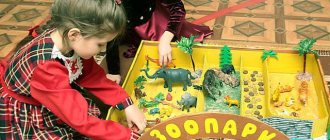Summary of the educational situation in the Senior group Topic: “Composing a story based on a set of toys”
Galina Reshetnyak
Summary of the educational situation in the Senior group Topic: “Composing a story based on a set of toys”
1. NGO "SPEECH DEVELOPMENT"
.
2. OS topic “
Making a story based on a set of toys .” (method. lit. - ra O. S. Ushakova)
.
3.Goal: “ Children compose creative stories based on a set of toys .”
5. Personally-oriented educational technology . The problem situation is created by the teacher using certain techniques, methods and forms. The formulation of a problem problem and the process of solving it occurs in the joint activity of the teacher and children. The teacher engages children in a joint mental search and provides them with assistance in the form of instructions, explanations, and questions. The teacher poses questions that encourage children, based on observations, research, previously acquired knowledge, to compare, contrast, and then come to conclusions through reasoning . Children freely express their thoughts, doubts, follow the answers of their comrades, agree or argue. Stages: creating a problem situation , finding ways to solve a learning problem, setting a learning task, solving, determining the effectiveness and diversity of the chosen methods for solving a learning problem, analyzing the results obtained.
7. All children made assumptions with desire and interest, took part in a collective discussion, in groups of three, agreed, distributed the work among themselves, and composed interesting stories (using the same material, but in different ways)
. Each child completed the task.
8. Analysis of the reasons for achievement. Using problematic technology, because all children love to explore, learn, observe, and experiment. Using a differentiated approach, working in groups of three, where coordinated work was observed: children shared their thoughts, children’s confidence was felt (I’m not alone, we are a team - providing psychological conditions for children’s creativity.) Mnemonics technology according to Bolsheva, TRIZ technique.
Goal: Children compile a coherent story based on a set of toys using the TRIZ technique.
Program content: teach children to compose a story based on diagrams: identify objects and their parts, establish relationships between objects, imagine possible sensations using different senses (TRIZ technique)
; activate children's vocabulary; teach children to negotiate and distribute work in groups of three; to form creative thinking in children; cultivate a sense of empathy and mutual assistance.
Integration: cognitive development, physical, artistic and aesthetic, social and communicative.
Materials, equipment: a set of toys (doll, house, plate, Christmas tree, puppy, bunny, table, easel, cards - diagrams (TRIZ, diagrams (according to Bolsheva), sheets of paper, simple pencils.
Preliminary work: drawing by the teacher “under the dictation of the children”
(during a joint discussion)
of subject-schematic
images of toys .
Progress of the lesson:
1. Telling a riddle.
What kind of forest animal
Stood up like a post under a pine tree
And stands among the grass,
- Look, guys, who came to visit us. Oh, hare, where are you from? And why so sad?
— The hare whispered in my ear that he was sad because he had no friends.
-Guys, let's help the hare find friends? How can we help him?
- That's right, let's write a fairy tale and find friends for the hare.
-How do fairy tales begin?
-We can say that there lived a hare in a certain kingdom, in a certain state?
-Who do such fairy tales begin about?
2. -Guys, before we start composing a fairy tale, let's remember the rules.
-That’s right, answer by raising your hand, don’t interrupt, listen to each other to the end.
-Guys, a fairy tale has a beginning, a middle and an end.
-I’ll start the story, and you will continue. Our fairy tale is called “How the Hare Found Friends”
“Once upon a time there lived a hare in a forest. He had no friends, so he was very bored. One day the hare decided to look for friends. He took a carrot with him and hit the road. He walked and walked and suddenly saw...
-Who did he meet? Squirrel, fox, bear, hedgehog...
-Come on, the hare met a hedgehog.
-What happened next?
-The hedgehog asked the hare:
- Hello, hare, where are you going? Why are you so sad?
-The hare replied that he was sad because he had no friends.
-The hare and the hedgehog became friends and they went on looking for friends.
-They walk and walk, the hare jumps and jumps, and the hedgehog doesn’t lag behind.
— A hare and a hedgehog are walking, and towards them (children’s answers)
-Come on, they met a fox.
-What happened next?
-How did the hedgehog help the hare? After all, real friends don't abandon each other in trouble?
-The hedgehog curled up and pricked the fox with its sharp needles.
-The fox ran away. That's all they saw.
-The hare was glad that he had found such a good friend.
- Here they are, walking, and they heard someone crying.
-And who sat there and cried?
- Come on, the little mouse was sitting, hurt his paw, lost his mother and cried bitterly.
-How did they help the mouse?
-They called the good Doctor Aibolit for help. The doctor treated the mouse's paw.
Here the mouse’s mother returned and thanked the hare, the hedgehog and Aibolit.
-Suddenly the evil, treacherous Barmaley appeared and took the hare, hedgehog and Aibolit to his castle and put him in a cage.
A hare, a hedgehog and Aibolit are sitting in a cage and crying. And there was a huge lock hanging on the cage, and the key to the lock was hanging on his neck.
-How did they manage to get out of the cage? Who helped them?
-Come on, let there be a mouse. How did she help?
-The mouse gnawed the string on which the key to the castle hung and brought it to his friends.
-Friends saved themselves from the evil Barmaley this way.
That’s how the hare found friends, and now he wasn’t sad. After all, it's more fun with friends!
-Here guys, we composed a fairy tale. Each of you told a piece , and now I will read you the whole fairy tale.
And after sleep, you will draw illustrations for our fairy tale and make an exhibition. And at home you will tell your parents the story .
Abstract of the educational activity for speech development “Compiling a descriptive story about a toy” Goal: to teach children to compose a descriptive story about a toy following the example of the teacher and with his little help, continue to teach children to answer.
Summary of educational activities for speech development in the middle group. Topic: “Drafting a descriptive story based on a toy” State budgetary preschool educational institution kindergarten No. 51 of a combined type, Moskovsky district of St. Petersburg.
Matryoshka
The Russian nesting doll is known and loved all over the world. The birthplace of the nesting doll is considered to be the city of Sergiev Posad, where a wooden lady was first made, from which, when opened, similar female figures of different sizes appeared. The invention of the Russian nesting doll dates back relatively recently - the end of the 19th century. During this period, the famous turner V.P. Zvezdochkin , who was engaged in the manufacture of wooden toys, at the request of the artist S.V. Malutina made a blank from wood, into which he placed the same opening blanks, but different in size.
The subject for painting the very first toy was the everyday affairs of Russian beauties. The matryoshka consisted of 8 wooden dolls. Later, the number of dolls varied and even reached 48 wooden ladies. Matryoshka dolls were produced in the artel of S.I. Mamontov in Sergiev Posad. The Russian nesting doll was exhibited at exhibitions in Paris. This amazing toy attracted the attention of foreigners, who began placing orders with Russian craftsmen.
Russian doll
Mostly matryoshka dolls were distributed, which consisted of 3, 8 and 12 dolls. The more dolls there were, the more valuable the matryoshka became. The main theme of the nesting dolls was everyday life. Most often they depicted the home activities of ladies. The girls were depicted in traditional outfits and always wearing a headscarf. The girls held sickles for the harvest, jugs of milk, and baskets of berries in their hands. Later, other subjects began to be depicted on matryoshka dolls, for example, characters from fairy tales and fables, heroes from stories by famous writers.
Once they tried to change the shape of the nesting dolls, for example, cone-shaped dolls appeared that were inserted into one another. But this form was not popular among the people, so the masters returned to the previous one.
The dolls also differed in their painting. Currently, the following types of painting are distinguished:
- Zagorsk (bright, rich colors and many small, clearly drawn elements);
- Merinovskie (large flowers);
- Semenovskie (strict symmetrical painting);
- Polkhovskie (image of rosehip flowers);
- Vyatskie (northerner young lady).
To make nesting dolls, linden is used, which, after painting, is coated with a transparent oil-based varnish. First, the craftsman grinds out the smallest solid figure. Then he makes the bottom of the next figure. After processing, this element dries well, and only then the upper part of the figure is adjusted. According to this scheme, all the components of the nesting doll are prepared. Dried parts must be treated with starch glue, which serves as the basis for painting. After the product has dried, begin painting the nesting dolls.
Matryoshka
First, the master draws the face. The head of the nesting doll is depicted covered with a scarf, which is painted in traditional Russian patterns. The type of clothing most often depicted is a sundress; sometimes it is complemented by an apron. The figurine is decorated with floral ornaments. After the paint has dried, a finishing layer is applied, which protects the nesting doll from moisture and chips.
Abashevskaya Russian folk toy
Abashevo Russian folk toy is made of clay. Its name comes from the village of Abashevo, Penza province. In the 19th–20th centuries. The best pottery masters lived in the village of Abashevo, whose works were valued throughout Russia. In the Penza province, in the village of Abashevo, there were rich deposits of clay, which was originally used to make beautiful dishes. Abashevo toys were first made in the mid-19th century for children's games. But after a while, the toys began to be given a satirical character, with the aim of ridiculing liars and those who profit from their neighbors.
The peak of development of the Abashevo toy came in the 20th century, when many craftsmen in making dishes from clay could no longer compete with factories. It was during this period that most craftsmen began making whistles, which aroused genuine interest and even delight among children. One of the famous masters of that period was Timofey Zotkin . His works had a significant influence on subsequent generations.
Abashevskaya Russian folk toy
The subjects of Abashev's toys are varied, among the main ones are animals and birds, the main feature of which is an overly long body with a neck and short legs. Animals were often depicted with lush curls and beards. Mostly they sculpted rams, deer, and goats. In appearance they resemble fantastic centaurs, which are characterized by some satire. Abashevo's toy is designed to ridicule human vices, especially love of money and deception. That is why, along with unusual animal figures, you can see an elegant young lady, a dashing horseman and a prince in the form of a ram with a human face.
When making a toy, the master uses clay and several stacks, with the help of which he forms a figurine, makes holes and patterns. Afterwards the product is fired and painted. To paint the Abashevo toy, craftsmen used oil and enamel paints, which ensured the durability and richness of the designs. The theme of the painting is, first of all, nature and the surrounding world, not devoid of symbolism. The Abashevo toy is dominated by red, green and blue colors.




